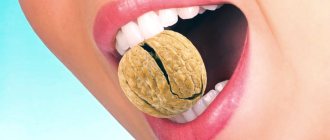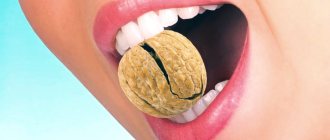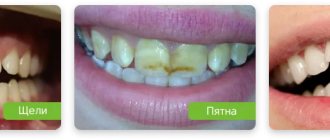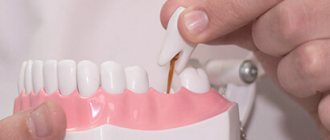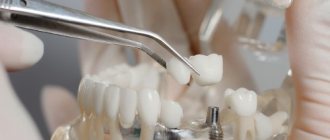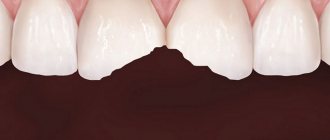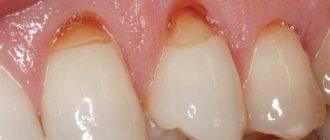Normally, there should be some transparency of the tooth enamel. Moreover, it varies in different zones. There are teeth with high, medium and low degrees of transparency, and dentists take this into account when selecting materials for restoration.
But the protective layer can become thinner and destroyed under the influence of microorganisms, acids and other negative factors. Then the transparency of the tooth enamel increases and becomes pathological.
Teeth with such changes are characterized by:
- increased fragility;
- chips;
- the appearance of cracks;
- sensitivity to sweet, sour, hot and cold;
- vulnerability to caries, periodontitis, and the appearance of neoplasms.
What to do if your teeth become transparent? Causes of thinning enamel and ways to restore it
When there are no signs of a pathological process and the integrity of the crowns is not compromised, and the teeth have become transparent, there is a reason to consult a specialist. There are many reasons for this phenomenon, and it is impossible to do without professional diagnostics. As a rule, such an anomaly indicates severe thinning of the enamel. Often in such cases, hyperesthesia occurs, that is, increased sensitivity. So why do teeth become transparent and what to do about it - read more about this later in this article.
Transparency of enamel - when is it normal and when is it pathological?
In normal condition, the tips of the front teeth - their cutting edges - remain slightly translucent, which is explained by the absence of dentin in these areas. With age, the degree of transparency may increase, which is associated with the gradual abrasion of the enamel, literally its wear and thinning. This is a normal process from a physiological point of view.
It’s another matter if the crowns acquired an unhealthy shine and became almost glassy for no apparent reason. Against the background of pathological thinning of the enamel layer, dentin begins to noticeably show through, which may have a yellowish, grayish or brown tint. A picture like this requires urgent medical attention.
If a child’s baby teeth become transparent up to the middle of the crowns, this may indicate the development of a pathological condition such as hypoplasia. In other cases, the symptom indicates increased abrasion of the enamel, which today occurs to one degree or another in approximately 12% of adults. At an advanced stage, it leads to dentin exposure, the appearance of serious aesthetic defects, the development of carious processes and tooth destruction.
Transparent teeth in a child may indicate a problem
Damage area
It is very rare for a tooth to become completely transparent.
If the teeth are clear at the ends or at the cutting part, then this is not a serious problem. Each person in this place has thinner enamel, and dentin is completely absent. Therefore, it seems that the cutting edge of the tooth is like glass. Also read: Prosthetics is important. Much more problems are created by fluorosis in the cervix and equator. Despite the fact that in the cervical area the enamel has a thin base, under its layer there is dentin.
Therefore, when the protective coating becomes thinner, the tooth becomes glassy and the yellow-brown color of the dentin appears. This creates the impression that caries has appeared and the enamel is covered with plaque. Due to this, the person is in an uncomfortable state, as he tries to control his smile.
Why does enamel thin and become transparent?
The teeth become transparent at the edges and beyond because the thickness of the enamel layer decreases. Various factors can provoke this phenomenon, and here are the main possible reasons:
- acute deficiency of phosphorus, calcium and fluorine in the body - the cause may be a harmful unbalanced diet and unfavorable environmental conditions in the place of residence,
- the use of inappropriate hygiene products - the thinning of the protective layer on the teeth is often the result of constant exposure to a hard brush and abrasive pastes, or too intense cleaning. All this leads to injury to hard tissues,
- too frequent bleaching - excessive aggressive effects of bleaching components do not go away without leaving a trace,
- abuse of foods high in acids and sugars, carbonated drinks,
- diseases of the stomach and intestines - many of them provoke increased acidity and changes in the pH environment in the oral cavity. Experts include such diseases as gastritis with frequent attacks of heartburn,
- abundant plaque and deposits - do not allow the enamel to be fully saturated with oxygen and create favorable conditions for the rapid proliferation of bacteria, leading to demineralization of the enamel and the development of caries,
- taking antibiotics and other potent medications,
- mechanical injuries – both one-time and permanent.
Too frequent bleaching can cause problems.
It should be noted that smoking can also provoke the development of pathology. Constant exposure to smoke and nicotine tars leads to changes in the structure of dental tissues, causing them to weaken and the enamel to become thinner. Another possible cause is heredity.
Preventive measures
At home, to inhibit the development of transparency, you need:
- brush your teeth in the morning and evening and rinse your mouth after each meal;
- include foods rich in minerals and vitamins in your diet;
- consume less sugar and quit the habit of chewing gum;
- change the brush regularly;
- Do not use toothpaste containing whitening elements.
Also read: Orthopedics in dentistry: what is it, what does an orthopedic dentist treat?
The listed methods help not to aggravate the problem and stop its development.
The brush must be of medium hardness. In some cases, it should be with a soft cleansing base. This will help avoid abrasion of the enamel layer during the cleaning process.
If you tend to have naturally translucent tooth enamel, you should avoid using an electric brush. This is explained by the high probability of injury, as the degree of mechanical impact on the protective layer of the teeth increases. To restore health, the help of specialists is necessary. The protective layer of enamel is quite difficult to effectively restore at home, using only folk recipes. Therefore, it is very important to follow the recommendations of your doctor and strictly follow the prescribed procedures. This is the only way to stop tooth decay and always have a beautiful smile.
What is the danger?
Thinning of the teeth at the ends leads to increased fragility of hard tissues, and then they begin to react sharply to any external stimuli: mechanical, temperature and chemical. Any damage can provoke infection and inflammation of the internal structures of the tooth, leading to the development of diseases such as caries, pulpitis, and periodontitis. In addition, the crowns themselves become weak and risk breaking under the chewing load.
According to statistics, this phenomenon most often occurs in middle-aged patients - from 30 to 50 years old1. At the same time, the pathological process itself is sluggish and can develop over a long period of time – 10-15 years. In the most advanced cases, dentin is exposed in some areas, which not only affects the appearance of the smile, but also causes severe pain.
Teeth become weak and may break
How to fix the problem - what dentistry offers
When answering questions about what to do if teeth have become transparent, and how to correct the defect, it should be noted that modern dentistry has all the necessary capabilities to solve the problem at any stage of its development. However, the sooner you see a doctor, the less money, time and nerves you will have to spend to return everything to the way it was. Below are the main methods that are used to correct such defects.
Fluoridation procedure
Demineralization is one of the main causes of thinning of the upper layer of teeth. To correct the situation, the tissues need to be saturated with useful substances and microelements. To do this, a fluoridation procedure is carried out - the enamel is coated with special fluoride-based preparations. According to reviews from patients and experts, such compositions strengthen hard tissues, restore their protective functions, and also slow down the process of calcium leaching.
Fluoridation will help strengthen your teeth
“I once wanted to buy fluoridated gel, I thought to strengthen my teeth, because at that time I noticed that sensitivity had appeared. It’s good that at the last moment I thought of going to the dentist for advice. The doctor immediately said that the remedy that I chose would not suit me. He prescribed a completely different drug, and before that he also had a procedure for removing plaque and stone. Otherwise, not only there was no effect, but it could have ruined my teeth. So it’s better not to do anything without consulting a specialist.”
Liliya V., from correspondence on the forum www.32top.ru
Remineralization course
Another similar procedure is remineralization. Their main difference with fluoridation is the use of different drugs, but the essence is the same. Remineralizing gels contain not only fluoride, but also useful minerals, vitamins, calcium, phosphorus and magnesium. The dentist selects the product based on the characteristics of each specific clinical picture.
Most often, doctors prescribe remineralization courses - 7-14 procedures. Within each of them, a specialist performs applications with a gel saturated with useful components2. Another option is to carry out the procedures yourself using special mouth guards, but their use must be agreed upon with the attending physician.
The remineralization procedure will help solve the problem.
Enamel implantation
Many people are familiar with the concept of “dental implantation,” but few know that enamel can also be implanted. The procedure is performed when there are obvious signs of demineralization, dentin exposure and hypersensitivity of hard tissues. Specialized products with a synthetic composition, for example, InnoDent, are applied to the surface of the teeth. By the way, this drug from the Junior series is used in pediatric dentistry.
Specialized products with a synthetic composition are applied to the surface of the teeth.
After applying the composition, the processes of natural regeneration of living tissues are launched, that is, the enamel layer and dentin are restored at the molecular level. The course lasts an average of a month, and during this time the teeth return to their original state.
Restoration with light composites
If there is a significant deterioration in the appearance of the smile and other serious problems caused by thinning, the doctor may suggest a more radical solution. In such cases, for example, extensions are carried out with light composites. Using this procedure, you can completely hide demineralized areas, as well as microcracks and chips, and adjust the shade.
Lighting composites will help solve the problem
Installation of veneers or lumineers - microprosthetics
Another possible solution to the problem is the installation of veneers or lumineers. We are talking about thin overlays that are fixed to the teeth using a special adhesive. With their help, you can hide many external defects, including chips, cracks, and traces of non-carious lesions. They also allow you to correct the size and shape of crowns, hide interdental spaces, and make your smile impeccably snow-white.
Veneers can be used in treatment
Replacing damaged teeth with crowns
In advanced cases, when the enamel has worn away too much and the teeth are literally destroyed, the only way out of the situation is prosthetics with artificial crowns. Such single dentures can be made of different materials: from solid metal to metal-ceramics, ceramics and zirconium dioxide. Products are created from impressions in a dental laboratory. The finished prosthesis completely matches the shape and shade of the living crown.
The issue can also be resolved using crowns
Tips for caring for enamel
To prevent any dental problems, doctors recommend adhering to the following rules on an ongoing basis:
- Brush your teeth twice a day.
- For this purpose, use only high-quality and properly selected hygiene products.
- Eat solid foods that can enrich the body with useful substances and stimulate the proper functioning of the jaw apparatus.
- Reduce the amount of sugar-containing foods and drinks in your diet. Avoid chewing gum.
- After each meal, you should rinse your mouth with clean water or special solutions.
- After 3-4 months, change your toothbrush to a new one, choosing the right hardness. The best option is medium.
- Massage your gums in the morning and evening.
- Do not use whitening pastes or similar recipes for home use.
- Visit your dentist's office twice a year for a professional examination of all surfaces and timely identification of emerging problems.
- It is advisable to give up bad habits, especially smoking.


